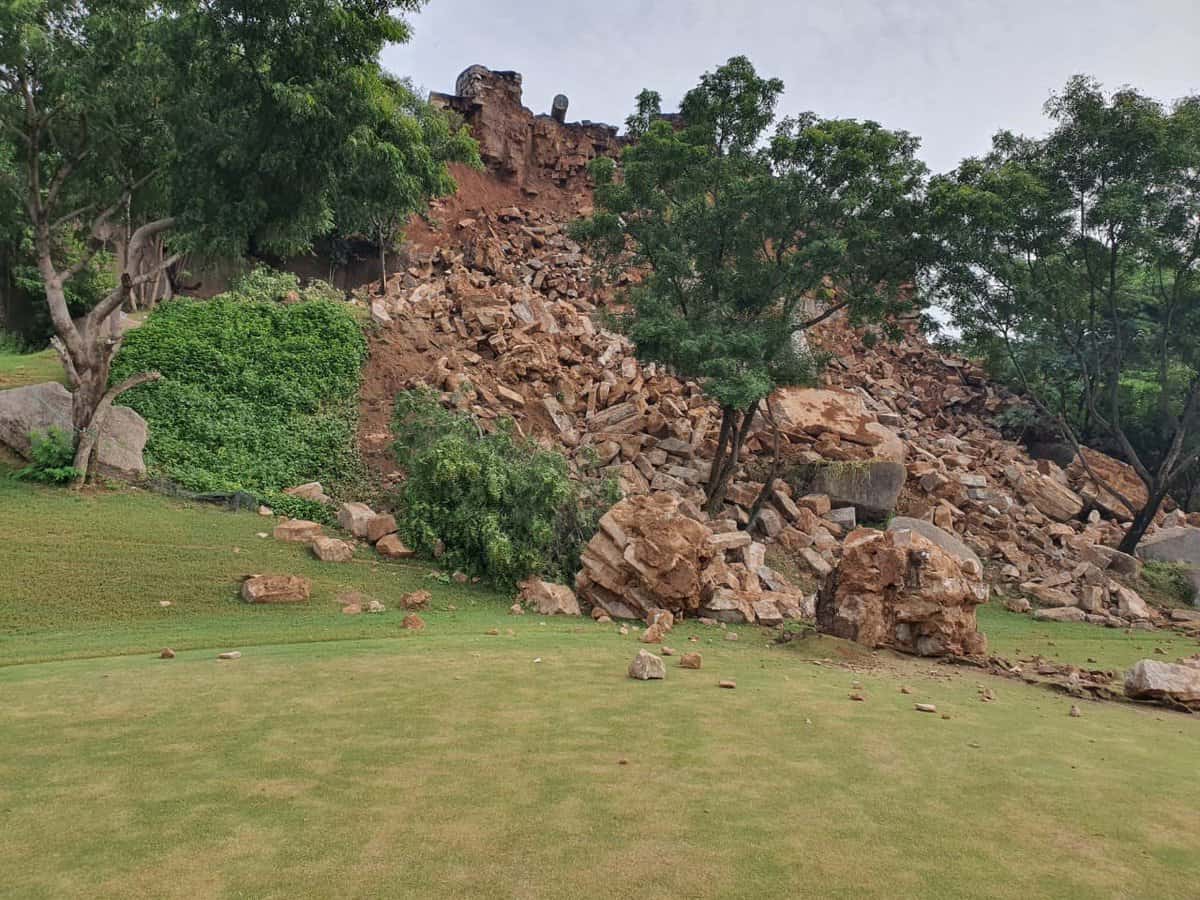Hyderabad: Nearly a year after its collapse during the last monsoons, the Majnu bastion in Golconda fort’s Naya Qila continues to be in a state of disrepair. The ancient historic site was one of the few places which witnessed damage during heavy rains last year in the fort. The Archaeological Survey of India (ASI), which runs the historical site, was supposed to undertake repairs, but that has not happened so far as wlel.
Last year in October, the bastion, or buruz (in Urdu), a huge portion of the historic Majnu Burj (bastion) in the Naya Qila came crashing down due to heavy rainfall that lashed Hyderabad in October. The bastion was already in a vulnerable state since September 2020, and wedge marks on the rock show indicated some human intervention with regard to the collapse. The incident is supposed to have transpired on October 9.
ASI officials said that so far all those who have been applying for the tenders to undertake repair works were not competent enough, hence the delay. The ASI’s in Telangana had sent repair estimates to its head office last year itself, but there has been no development since then.
The issue of Golconda fort’s upkeep was in focus earlier this year as well, when the Telangana High Court pulled up the state government and ASI, asking what both government bodies were doing with regard to the maintenance of the fort, and also the Qutb Shahi tombs complex, which is currently being restored by the state’s Heritage department and the Aga Khan Trust for Culture (AKTC).
Last year’s torrential rainfalls also damaged another part of the Golconda fort as well in its ticketed area. The Naya Qila area is in fact believed to be about 500 years old, and is a part of the Golconda dynasty’s (which founded Hyderabad in 1591) remaining heritage in our city. The Naya Qila area, which is now cut-off from the Golconda fort due to local encroachments, was developed into an external fortification after the first Mughal attack (during the time of Emperor Shah Jahan) on Hyderabad in 1656.
Opposite the Majnu Bastion is the Laila Bastion. Other parts of Naya Qila which are open to the public are the Baobab tree, which is believed to be over 400 years old (it is said to have been planted there by African friars), the Mustafa Khan Masjid (which was built in 1561 and predates Hyderabad), and the Mulla Khyali Masjid, which is believed to be named after the Deccan poet Mulla Khyali.
While the Majnu Bastion’s collapse is the latest instance of the city’s heritage getting damaged, in the past the HGA had also disallowed the general public from entering the Naya Qila area. However, according the ASI, there is no such restriction and the public is free to visit the place. Given the current damage, the ASI has barred people from entering the vicinity.
The Golconda Fort and the Charminar are two monuments that fall under the jurisdiction of the ASI, which works the central government, while all the other heritage sites like the Qutb Shahi Tombs come under the purview of the Archeology Department of Telangana government. Last year, a petition A petition was also created to save Naya Qila and the Golconda fort by local Hyderabadis. Link: https://chng.it/CFKtfQjYrb
History of the Golconda fort
The Golconda Fort’s origins are traced back to the 14th century when the Rajah of Warangal Deo Rai (under the Kakatiya Kingdom which ruled from Warangal) built a mud fort. It was taken over by the Bahmani Empire between 1358 and 1375. Later, it was developed into a full-fledged citadel by Sultan Quli who founded the Qutb Shahi kingdom in 1518 following the death of last sovereign of Bahmani Emperor Mahmud Shah.
Sultan Quli was a commander and later governor of Tilang (Telangana), under the Bahmani Empire (1347-1518), when its second capital was at Bidar. Sultan Quli, who was originally from Hamadan in Iran, rose to the level of Governor under the Bahmani Empire in early 16th century. At this point of time he was given the fort, around which he began developing a walled-city. It eventually came to be called Golconda Fort (name derived from Telugu Golla-conda, or shepherds hill).
The fort has 87 bastions, and eight gates, of which a few are not accessible to the general public as they are under the army control. It is believed to be one of the Deccan’s most impregnable forts, and had kept Mughal emperor Aurangzeb’s army at bay for eight months until he succeeded and conquered Hyderabad in 1687.
Hyderabad was founded in the year 1591 by Mohd. Quli Qutb Shah, the grandson of Sultan Quli, with the Charminar being the city’s foundation. The city turned 429 years old in 2020.







